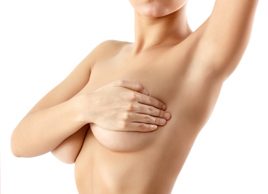Breast Thermography: A new way to detect breast cancer
This non-invasive breast assessment could be the next big thing in breast-cancer detection

Source: Best Health magazine, October 2012; Image: Thinkstock
If you haven’t heard of breast thermography, you’re not alone. The non-invasive, radiation-free and compression-free assessment of breasts, meant to help in the detection of early breast cancer, has been approved for use as an adjunctive test in the U.S. since 1982, but is not yet sanctioned by Health Canada. Alexander Mostovoy, a homeopathic doctor in Toronto and clinic director of Thermography Clinic Inc., says, ‘It is simply an additional assessment procedure to help diagnose breast cancer.’ According to Mostovoy, the medical community is increasingly learning about breast thermography. He anticipates that in five to 10 years, doctors and the general public will know much more about the procedure. Here’s what to know about the test.
How it works
Breast thermography measures the heat that is constantly radiating from our breasts (abnormal tissue generates more heat than normal tissue). High-resolution images of the breasts are taken with an infrared camera to show temperature differences in what could be cancerous tissue, as well as chemical or blood vessel activity that may be occurring and could potentially lead to cancer. An abnormal infrared image is considered a risk factor for developing breast cancer.
Mammograms take X-rays of lumps that are large enough to be seen; breast thermography may identify changes in cancerous breast tissue before tumours even appear. And while Health Canada recommends mammograms for women between the ages of 50 and 69 every two years, or earlier if there is a family history, thermography is ideal for women of any age who have dense breasts or breast implants. It’s also beneficial and safe for young women and those who are pregnant, breastfeeding, or pre- or post-menopausal.
The Canadian Breast Cancer Foundation says thermography should not be used to replace regular mammograms. When it is used as part of a multi-modal approach that includes clinical examination and mammography, 95 percent of early breast cancers can be detected. And there is a 61 percent increase in survival rates for women who add thermography to their regular breast-health checkup.
What to expect during the procedure
Breast thermography involves disrobing from the waist up and sitting for 15 minutes in a temperature-controlled room that is between 18 and 22°C. A clinical certified thermography technician takes ‘before’ images of your breasts with an infrared camera from various angles. Then you are asked to plunge your hands into 10°C water for 60 seconds. The shock of the cold water will send your body into a ‘fight or flight’ response, causing blood vessels in a healthy breast to constrict. The infrared images are then taken again. Afterwards, the technician sends both sets of photos to be read by a board-certified clinical thermographer (BCCT). BCCTs must already hold an active medical licence. Technicians are not necessarily nurses but have been specifically trained in thermographic imaging.
A report is available in five to seven business days, at which time you meet again with the technician to discuss the results, and receive advice on breast health and prevention of breast disease. You will also be encouraged to give a copy of the thermog¬raphy report to your family physician.
‘After losing one breast to breast cancer, I went searching for information on prevention and found the Thermography Clinic in Toronto,’ says Mary Kubisewsky, a breast-cancer survivor and clinic director of Thermography Clinic Kitchener Inc. in Kitchener, Ont. ‘I was so impressed with the technology and I felt relieved after finding out my remaining breast was ‘low-risk’ for breast cancer. I opened my own clinic a year later because I wanted to bring the technology to other women.’
This article was originally titled "What is breast thermography?" in the October 2012 issue of Best Health. Subscribe today to get the full Best Health experience’and never miss an issue!




